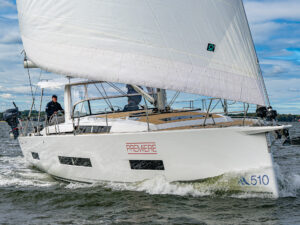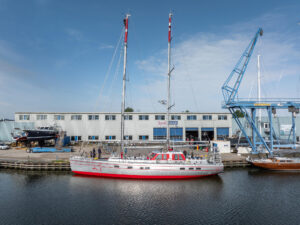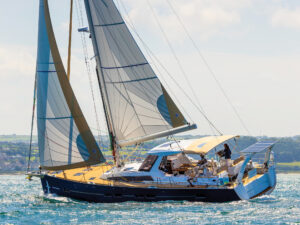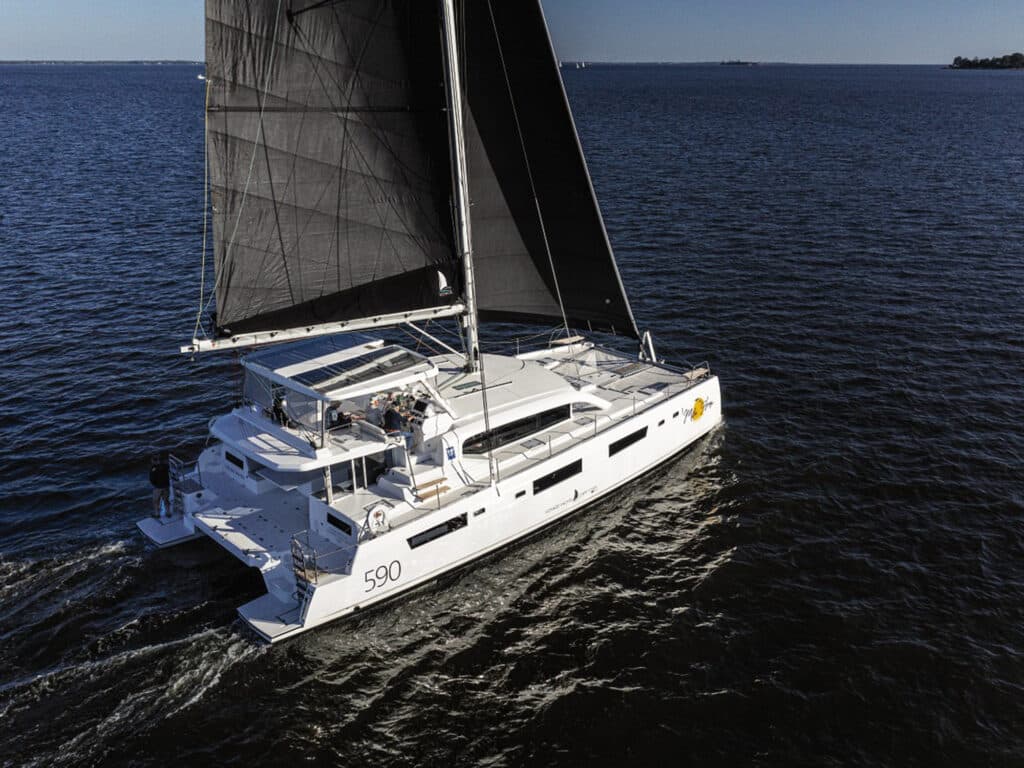
Over the years, I’ve heard marketing folks offer some pretty ambitious descriptions of a given vessel’s aims and capabilities. A couple of years ago, a sales rep said that I could take his company’s new 40-something-footer and “do a Bermuda Race on it, or live aboard, or sail around the world.” Except the deck layout was horrible for racing, the galley and storage were too tight for long-term habitation, and there wasn’t nearly enough tankage for crossing oceans. In reality, it was a pretty fair coastal cruiser. Unsurprisingly, it didn’t win any prizes.
In sharp contrast to that experience, it was refreshing to step aboard the Voyage 590. The marketing was actually the straightforward skinny: This 59-foot cat, built in South Africa, is a high-end charter boat with a half-dozen equally sumptuous staterooms. Not a long-range cruiser. Not for living aboard.
What’s more, it has one and only one chartering venue: the British Virgin Islands, from a base at Tortola’s Soper’s Hole. Not the Mediterranean or South Pacific—just the BVI. Simple, no? What wasn’t said is that the 590 is an engineering marvel that addresses its design writ superbly. But I was about to discover all that on my own.
Voyage founders Robin and Jo-Ann Downing set out from South Africa to the Caribbean aboard their own boat—a custom monohull design that Robin was not only sailing, but also selling—nearly 40 years ago. They then returned home and switched allegiances to cruising catamarans. The first two Voyage cats launched in 1995. By 2017, Voyage ran some 30 charter boats in the BVI and offered dedicated cruising boats beyond those sold into their charter-management program.
Then Hurricane Irma happened, decimating their fleet. With help from their three kids (and their spouses), the Downings regrouped and carried forth with their family-run BVI charter business. It is now replenishing its charter-boat numbers, at this time exclusively with the 590. Going forward, the company has completed preliminary designs for “owner’s layouts” with fewer staterooms, as well as different amenities for long-range cruising and living aboard. The first is expected to launch in early 2024.
Phil Southwell is the company’s current naval architect of record, but the 590’s concept, layout and objective are all Robin Downing’s. And he is clear about what he was after.
“It’s a six-cabin layout with slightly different configurations but all of equal size,” he said. “It fills a niche in the market.”
Of course, not everyone wants to vacation with a dozen companions, but if you do, here you go. Bareboats are available to super-qualified sailors—we’re basically talking longtime, repeat customers—but many charter parties go all-inclusive with a captain and chef, or at least a captain. Which makes sense. The 590 is a lot of boat, my friends. As such, it was named Best Charter Boat in CW’s 2022 Boat of the Year competition.
The comfort of vacationers was on Downing’s mind when it came to propulsion and charging systems. The 590 is available in a dedicated all-electric version, or a hybrid setup with a diesel engine for propulsion augmented by a set of Bellmarine electric generators (and accompanying solar panels). In all instances, there’s a bank of lithium-ion batteries. Voyage wants its guests to enjoy full nights of air-conditioned comfort without the noise and bother of a diesel generator. Anyone who has picked up a mooring in a crowded BVI anchorage will also appreciate this silence.
“It’s a techy boat, and they’re doing a lot of cool things with lithium tech and 24-volt systems,” BOTY judge and systems expert Ed Sherman said. “In terms of the systems integration, they’re using very high-end inverters with variable-speed air-conditioning systems that step down as it gets cooler at night. That’s pretty cool stuff. They’ve selected the MG lithium battery banks, which were originally created and designed by Victron Energy in Europe. And there are a lot of refrigeration units on board. They want to make sure the beer is chilled, and they went to great lengths to ensure that it is.”
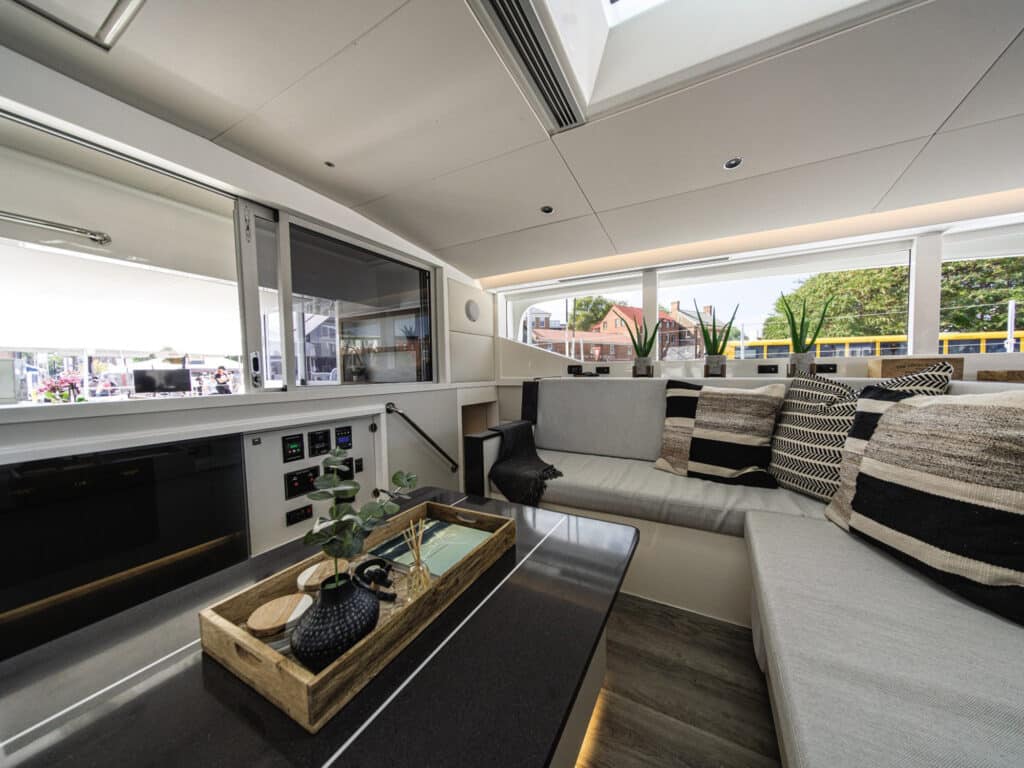
Nothing is simple about the 590’s construction, including the hand-laid, three-piece hull mold. There’s another vast mold for the deck. All of it, including the structural grid, is foam-cored and vacuum-bagged in a laminate that incorporates a vinylester skin. It’s all extremely solid and well-executed.
How to describe the rest of the boat? My notes had two related entries: “laid out for gracious living” and “party palace.” Both were meant to be high compliments.
Stashed in the hulls, those aforementioned six staterooms—four with athwartships bunks, and another pair with fore-and-aft berths—are indeed of equal size and appointments, though with different color schemes and accoutrements for a bit of variety. Topside and aft, swim platforms in each hull step up to a wide boarding platform that accesses the cockpit, with sliding doors that lead to the saloon. With those doors open, the layout makes for a sweeping, integrated space. There’s an outdoor grill, naturally, and a couple of members of the related fridge family. The dining table is long and wide enough for the entire New England Patriots offensive unit.
The galley is forward with a window for ventilation and easy entree to a forward cockpit, in the event one wishes to throw separate parties at the same time. Five steps lead up to the flybridge, which hosts all the sailing controls and running rigging, ably tamed by a trio of electric stainless-steel Andersen winches and a series of Spinlock clutches managing color-coded lines. A single wheel is to starboard, with engine controls for the twin Yanmars and a suite of B&G instrumentation. There’s a hard Bimini overhead with windows to the mainsail, in addition to the windshield. Sun pads for lounging are here, there and everywhere.
The gargantuan mainsail is of course raised by an electric winch, and I was surprised to see what I thought was a black carbon laminate, but it turned out to be Dacron painted black (it still looked cool as could be). The next surprise under sail was the steering, which I thought would be hydraulic on such a beast of a boat. It turned out to be a standard wire Lewmar arrangement that wasn’t exactly sensitive, but it was more than adequate. In 8 to 10 knots of breeze upwind, we made better than 6 knots and sped up to better than 7 on a reach. The fact that these boats are delivered on their own bottom to the Caribbean is a testament to their seaworthiness.
I asked Robin about top-end boatspeed, and with a look of mock horror, he said: “You don’t want to ever do more than 12 on this boat. It’s 26 tons.” He then listed the many things you’d need to compromise to go faster: slender hulls (which would erase the spaciousness of the accommodations), a higher bridge deck (ditto) and so on. Besides, on the 590, haste is definitely not the point of the exercise.
BOTY judge Gerry Douglas said that the 590 reminded him of “a boutique hotel.” His words ring true to me, and I personally would be more than happy to check in anytime.
Voyage 590 Specifications
| LOA | 58’3″ |
| LWL | 57’9″ |
| BEAM | 28’5″ |
| DRAFT | 5’2″ |
| SAIL AREA | 2,175 sq. ft. |
| DISPLACEMENT | 60,186 lb. |
| D/L | 145 |
| SA/D | 22.7 |
| PRICE | $2,300,000 |
| Website | voyageyachts.com |

